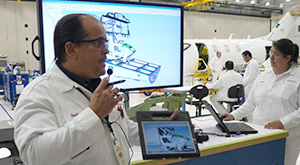
With more than $100 million in infrastructure investment at Piedmont Triad International Airport in Greensboro, N.C., Honda Aircraft Company is on schedule to certify its unusual HondaJet by the end of 2012. Company officials showed off the pristine new facilities to media representatives July 12 and allowed an up-close look at its first conforming flight test airplane.

Honda Aircraft Company President and CEO Michimasa Fujino indicated that the Model 420 HondaJet was just the beginning of a family of products.
Honda has long dabbled in aviation with a dream of producing airplanes, said Honda Aircraft Company President and CEO Michimasa Fujino. As a company focused on mobility, the addition of aircraft to a product line that includes everything from scooters to motorcycles to cars makes sense. Honda announced in 2006 that it was going into production with the HondaJet, a proof-of-concept of which had been flying since December 2003.
Since then the POC has flown some 500 hours on 400 missions. The first production conforming airplane joined the flight test program in December 2010; a second conforming airplane should be flying in weeks, and a third by the end of the year.
The conforming airplanes have been assembled in a new 500,000-plus-square-foot factory complex at Piedmont Triad International. The complex includes a headquarters building, a research and development facility, and a production facility. The R&D facility hums with activity as the project moves toward planned certification next year. Meanwhile, the cavernous production facility with its four high-tech paint booths sits nearly empty as gear and equipment begin to arrive to ramp up production. Company officials expect 70 to 100 airplanes to be produced a year at the facility. Honda does not release exact order numbers, but indicated it had “more than 100.” However, one staff member indicated the number was closer to 200 than 100.
 Meanwhile, Fujino and other staff members numerous times throughout the media day indicated that the Model 420 HondaJet was just the beginning of a family of products. With its constant cross-section fuselage, the fuselage can easily be stretched. “I would like to design and build one more airplane,” Fujino told AOPA Pilot at the event. The current model, with its unusual system of mounting the engines on pylons atop the wing, is Fujino’s own design.
Meanwhile, Fujino and other staff members numerous times throughout the media day indicated that the Model 420 HondaJet was just the beginning of a family of products. With its constant cross-section fuselage, the fuselage can easily be stretched. “I would like to design and build one more airplane,” Fujino told AOPA Pilot at the event. The current model, with its unusual system of mounting the engines on pylons atop the wing, is Fujino’s own design.
With the low-drag engine configuration and specially designed natural laminar flow wing and cockpit area, the airplane easily makes its target cruise speed of 420 knots true airspeed, according to flight test pilots. The airplane has an expected IFR range of 1,180 nm and can fly as high as 43,000 feet.
AOPA Pilot was first to do an in-depth report on the new design in 2005.




